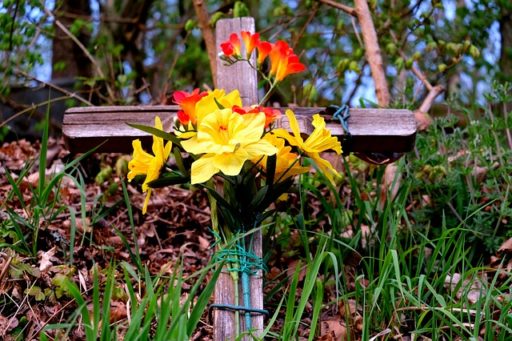For years, before I worked from home full-time, every day I would pass the site of a murder on my drive home from the office. I live in an inner-ring suburb of Washington, DC, a mile from the District line, which has little lines of little brick Colonials stair-stepped up hills. It was a working-class Catholic neighborhood; then it was a middle-class black neighborhood; and now it has been overlaid with representatives of the over-educated and under-paid.
The span of ten miles from my office on the Potomac River—where sunlight from its water flashed light through the plate-glass windows—was like traveling through layers of shale through sociology and time. I’d leave my building in the prosperous West End, and after a few dog-legged turns, would end up on the long northeastern line of New York Avenue that was like another city entirely: old warehouses that had not yet been turned into hot yoga studios and craft breweries, and, wandering at all hours, people who were either actually homeless or had been housed, temporarily and ineffectively, in the old motels lining the roadway.
The dead man was, in fact, homeless, and I came on the scene not long after his murder, next to a concrete embankment past the Florida Avenue intersection. I was driving home late from a songwriter friend’s concert—my husband and son already asleep at home—when I came upon the clot of traffic and rotating squad car lights, and the line of crime-scene markers numbering the drips of blood on the sidewalk. There was a brief report in the Metro section of the Post, but the main memorial was a red, spray-painted graffito on the embankment: Lefty was here.
A year later to the day, I passed a candlelight vigil of homeless folk next to Lefty’s overpass, but that was the last evidence I’ve seen that “Lefty” existed. That was 2007. Sadly, a Google search for “Lefty homeless murder New York Avenue” indicates that there were far more murders than just this one.
When Lefty left his life, though, he became part of mine. I cannot pass the concrete overpass—bleached clean, now deserted amid the pandemic—without remembering Lefty. I pray for him, and when I do, the contours of his being take shape once more in my mind. And not only do I believe that I imagine this: I believe that in some sense I am partaking in something—somewhere—that is real.
I’m thinking about Lefty because I worry about the growing disappearance of death—and by extension, the remembrance of death—from physical space in America. It’s not new: “Have you heard about the revolution in the funeral industry?” my brother the financial manager declared to me, years ago now—the growing preference for cremation over physical burial.
I don’t want to pick on cremation, per se. Some of that preference is cost-motivated, of course. The commercials for Colonial Penn whole-life policies on late-night TV remind me that “final expenses can cost up to $10,000,” and for millions of Americans that’s an impossible number—especially when there are convenient ads for $875 cremations.
And cremation itself need not necessarily be an evasion of the physicality of death: I spent three of the most intense days of my life in Varanasi, India, where I saw bodies wrapped in linen being hoisted onto pyres that smoked out over the Ganges River at dawn. Everything around me was imbued with the physicality of remembrance—down to the soot-filled air. The surreal experience was unsettling in light of my own Western Christian background, but it was totalizing, awesome, reverent nonetheless.
I’m not sure that the growing American preference has as much metaphysical heft, though. There’s an environmental concern about cemeteries and burial, but that’s overshadowed for the most part by a kind of nineteenth century Romanticism about “returning to the earth” by scattering ashes. (I had a relative whose “cremains” were tossed from a helicopter over a major U.S. city, which would seem to not quite fulfill that narrative.)
More often, I think, people are motivated simply by their plain belief that we are given this world only, and that the disposition of the body is thus beside the point. But what is the cost for those who are left behind? I have had two beloved neighbors now who died in the past few years, who, with no external or religious commitments to stop them, for all intents and purposes, just… disappeared. There would be no funeral; there would be no stone. At least with a body given to science, the life is reincarnated in others.
I don’t need to say that all of this is worse in this time when we are separated from our loved ones who are dying, when they—and we—so often find ourselves alone.
Which means, instead, that the locus of mourning is shifted—to the ground and to the built environment. I can almost feel the bricks of my neighbors’ house hold themselves as an ark where my friend once lived; it is why that concrete overpass on New York Avenue is as hard and firm a testament to eternity as I can imagine. And as much as everything else dissipates into air, it is why I love those makeshift crosses at the side of the road, the rain-bedraggled stuffed animals crucified on stop signs.
It is also why, all these trends notwithstanding, I hold to my Orthodox tradition’s belief in the burial of the whole body—and the open casket, the press of lips on the cold forehead (though often covered with an icon-painted ribbon). These are our bodies, and they are how we know history. They are how we know ourselves.
We are monument makers. We must choose wisely the monuments we choose to make.
Caroline Langston was a regular contributor to Image’s Good Letters blog, and is writing a memoir about the U.S. cultural divide. She has contributed to Sojourners’ God’s Politics blog, and aired several commentaries on NPR’s All Things Considered, in addition to writing book reviews for Image, Books and Culture, and other outlets. She is a native of Yazoo City, Mississippi, and a convert to the Eastern Orthodox Church. She lives outside Washington, D.C., with her husband and two children.





